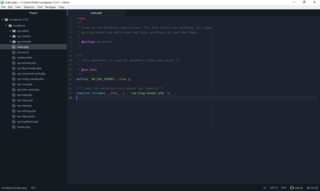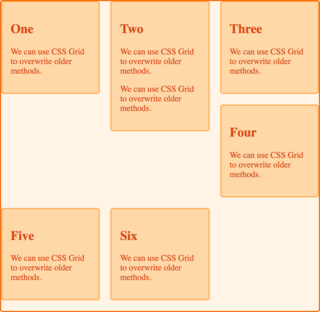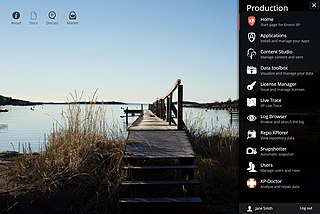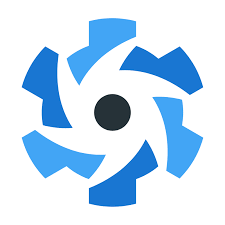Web development is the work involved in developing a website for the Internet or an intranet. Web development can range from developing a simple single static page of plain text to complex web applications, electronic businesses, and social network services. A more comprehensive list of tasks to which Web development commonly refers, may include Web engineering, Web design, Web content development, client liaison, client-side/server-side scripting, Web server and network security configuration, and e-commerce development.

TinyMCE is an online rich-text editor released as open-source software under the GNU General Public License version 2 or later. It converts HTML textarea fields, or other designated HTML elements, into editor instances.

WaveMaker is a Java-based low-code development platform designed for building software applications and platforms. The company, WaveMaker Inc., is based in Mountain View, California. The platform is intended to assist enterprises in speeding up their application development and IT modernization initiatives through low-code capabilities. Additionally, for independent software vendors (ISVs), WaveMaker serves as a customizable low-code component that integrates into their products.
A CSS framework is a library allowing for easier, more standards-compliant web design using the Cascading Style Sheets language. Most of these frameworks contain at least a grid. More functional frameworks also come with more features and additional JavaScript based functions, but are mostly design oriented and focused around interactive UI patterns. This detail differentiates CSS frameworks from other JavaScript frameworks.

Vaadin is an open-source web application development platform for Java. Vaadin includes a set of Web Components, a Java web framework, and a set of tools that enable developers to implement modern web graphical user interfaces (GUI) using the Java programming language only, TypeScript only, or a combination of both.

Flask is a micro web framework written in Python. It is classified as a microframework because it does not require particular tools or libraries. It has no database abstraction layer, form validation, or any other components where pre-existing third-party libraries provide common functions. However, Flask supports extensions that can add application features as if they were implemented in Flask itself. Extensions exist for object-relational mappers, form validation, upload handling, various open authentication technologies and several common framework related tools.

Bootstrap is a free and open-source CSS framework directed at responsive, mobile-first front-end web development. It contains HTML, CSS and (optionally) JavaScript-based design templates for typography, forms, buttons, navigation, and other interface components.

The Chromium Embedded Framework (CEF) is an open-source software framework for embedding a Chromium web browser within another application. This enables developers to add web browsing functionality to their application, as well as the ability to use HTML, CSS, and JavaScript to create the application's user interface.
Foundation is a free responsive front-end framework, providing a responsive grid and HTML and CSS UI components, templates, and code snippets, including typography, forms, buttons, navigation and other interface elements, as well as optional functionality provided by JavaScript extensions. Foundation is an open source project, and was formerly maintained by ZURB. Since 2019, Foundation has been maintained by volunteers.

Atom is a free and open-source text and source-code editor for macOS, Linux, and Windows with support for plug-ins written in JavaScript, and embedded Git control. Developed by GitHub, Atom was released on June 25, 2015.

Ionic is an open-source UI toolkit for building cross-platform mobile, web, and desktop applications using web technologies such as HTML, CSS, and JavaScript/TypeScript. It provides a set of pre-designed UI components and tools for building high-quality, interactive applications. Ionic was originally built as a complete open-source SDK for hybrid mobile app development created by Max Lynch, Ben Sperry, and Adam Bradley of Drifty Co. in 2013. The original version was released in 2013 and built on top of AngularJS and Apache Cordova. However, the latest release was re-built as a set of Web Components using StencilJS, allowing the user to choose any user interface framework, such as Angular, React or Vue.js. It also allows the use of Ionic components with no user interface framework at all. Ionic provides tools and services for developing hybrid mobile, desktop, and progressive web apps based on modern web development technologies and practices, using Web technologies like CSS, HTML5, and Sass. In particular, mobile apps can be built with these Web technologies and then distributed through native app stores to be installed on devices by utilizing Cordova or Capacitor.

Visual Studio Code, also commonly referred to as VS Code, is a source-code editor developed by Microsoft for Windows, Linux, macOS and web browsers. Features include support for debugging, syntax highlighting, intelligent code completion, snippets, code refactoring, and embedded version control with Git. Users can change the theme, keyboard shortcuts, preferences, and install extensions that add functionality.

Electron is a free and open-source software framework developed and maintained by OpenJS Foundation. The framework is designed to create desktop applications using web technologies that are rendered using a version of the Chromium browser engine and a back end using the Node.js runtime environment. It also uses various APIs to enable functionality such as native integration with Node.js services and an inter-process communication module.

PostCSS is a software development tool that uses JavaScript-based plugins to automate routine CSS operations. It was designed by Andrey Sitnik with the idea taking its origin in his front-end work for Evil Martians.
Angular is a TypeScript-based free and open-source single-page web application framework run on Node.js. It is developed by Google and by a community of individuals and corporations. Angular is a complete rewrite from the same team that built AngularJS. The Angular ecosystem consists of a diverse group of over 1.7 million developers, library authors, and content creators. According to the Stack Overflow Developer Survey, Angular is one of the most commonly used web frameworks, second to React.

In Cascading Style Sheets, CSS grid layout or CSS grid creates complex responsive web design grid layouts more easily and consistently across browsers. Historically, there have been other methods for controlling web page layout methods, such as tables, floats, and more recently, CSS Flexible Box Layout (flexbox). CSS grid is currently not an official standard although it has been adopted by the recent versions of all current major browsers.

Enonic XP is a free and open-source web application platform and content management system (CMS) in one based on Java and Elasticsearch. Developed by the Norwegian software company Enonic, the microservice web platform can be used to build progressive web applications, Next.js websites, or web-based APIs. Enonic XP uses an application framework for coding server logic with JavaScript, and has no need for SQL as it ships with an integrated content repository. The CMS is fully decoupled, meaning developers can create traditional websites and landing pages, or use XP in headless mode, that is without the presentation layer, for loading editorial content onto any device or client. Enonic is used by major organizations in Norway, including the national postal service Norway Post, the insurance company Gjensidige, the national lottery Norsk Tipping, the Norwegian Labour and Welfare Administration, and all the top football clubs in the national football league for men, Eliteserien.
Next.js is an open-source web development framework created by the private company Vercel providing React-based web applications with server-side rendering and static website generation.

The Quasar Framework is an open-source Vue.js based framework for building apps with a single codebase. It can be deployed on the Web as a SPA, PWA, SSR, to a Mobile App, using Cordova for iOS & Android, and to a Desktop App, using Electron for Mac, Windows, and Linux. Quasar was created by Razvan Stoenescu and is maintained by a small team of developers and contributors. Most from the core team currently work at various companies such as Lenovo, IntelliView Technologies Inc. and AG Development Services.
Tailwind CSS is an open-source CSS framework. The main feature of this library is that, unlike other CSS frameworks like Bootstrap, it does not provide a series of predefined classes for elements such as buttons or tables. Instead, it creates a list of "utility" CSS classes that can be used to style each element by mixing and matching.














